Unlike most states, Oregon never got around to adopting an official nickname. That said, many people refer to it by its unofficial nickname, The Beaver State. This name highlights the state’s natural heritage and pays homage to the plants and animals that live there, including the beaver. The state is also home to many species of spiders ranging from giant house spiders to tiny jumping spiders. Here is a list of 10 spiders in Oregon that you can often find in The Beaver State.

#10. Grey House Spider
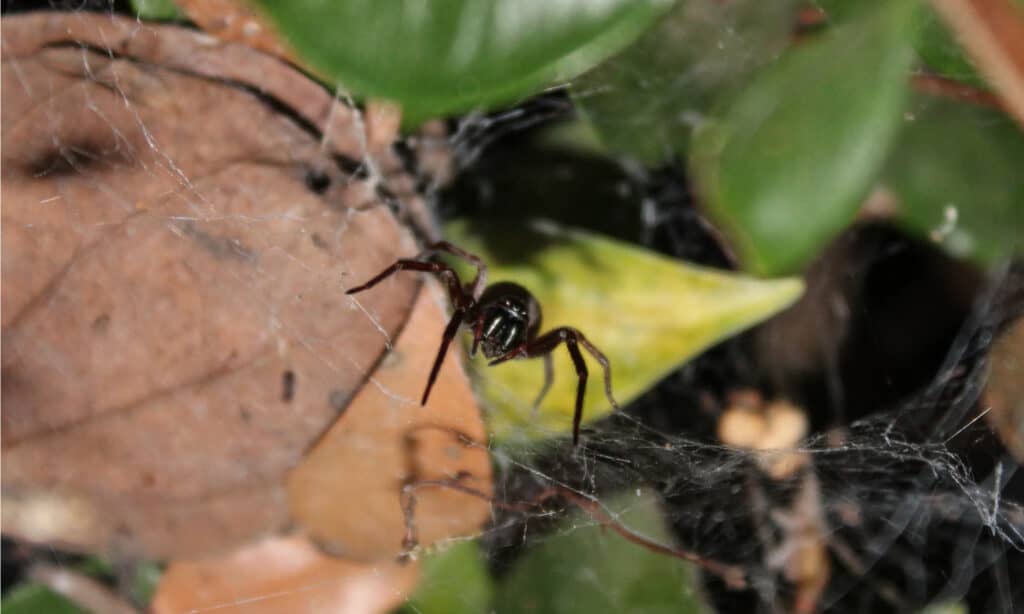
The grey house spider originally hails from Australia.
©Cassandra Madsen/Shutterstock.com
The grey house spider, Badumna longinqua, belongs to the intertidal spider family Desidae. Although it originally comes from Australia, you can now find these spiders in Oregon and other parts of the United States, Europe, Asia, and South America.
Adult females can reach up to 14 millimeters long and males generally average about 10 millimeters long. They appear predominantly light grey except for some black marks on the abdomen. Meanwhile, their relatively short legs look purplish-brown with dark bands.
As their name implies, grey house spiders often build their webs inside human dwellings. They create tangled cobwebs in or around small cracks or crevices that they use to capture prey. They hide during the day and then emerge at night to wait for prey to fall into their ladder-shaped webs. While venomous, their bite poses little danger to humans.
#9. Hobo Spider

Hobo spiders get a bad rap, as many people consider them dangerous.
©SNEHIT PHOTO/Shutterstock.com
Eratigena agrestis, or the hobo spider, is one of the more misunderstood spiders in Oregon. It gets its name from the commonly held belief that the species travels by hitching rides in cars and other vehicles. A member of the funnel web spider family Agelenidae, you can find these spiders throughout Europe, Central Asia, and the western half of North America.
Adult hobo spiders measure from 7 to 14 millimeters long, with males measuring smaller than females. They appear almost entirely brown except for several light V-shaped markings down the abdomen. Additionally, they frequently feature a light stripe in the middle of the sternum.
Hobo spiders wait in the rear of their trampoline-shaped webs for prey. They typically build their webs in fields and tend to avoid human habitats. As a result, human encounters happen rarely. Many people consider them dangerous, but in reality, their bites are not medically significant.
#8. Mouse Spider
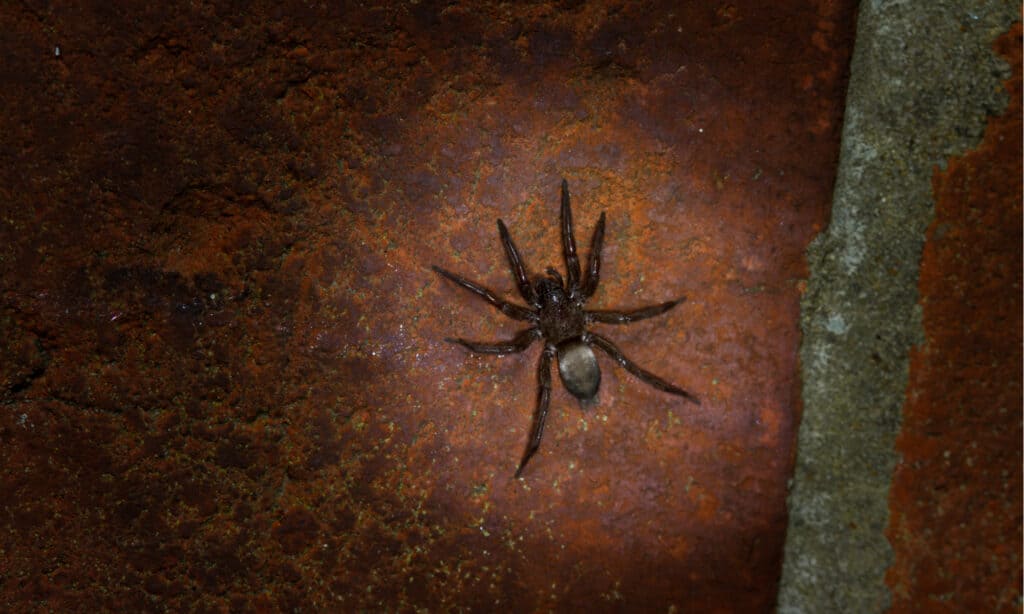
The mouse spider faintly resembles a mouse due to its erratic movements and grey, velvety hairs.
©thatmacroguy/Shutterstock.com
Scotophaeus blackwalli is more commonly known as the mouse spider. It belongs to the ground spider family Gnaphosidae and ranges extensively throughout northern Europes and parts of the United States. Some people confuse it with the more dangerous mouse spiders of Australia and Chile, but it is not closely related.
Adult females can grow up to 12 millimeters long. Meanwhile, males usually measure no more than 9 millimeters in length. The carapace typically looks dark brown while the abdomen appears brownish-grey with short, velvety hair. These hairs and the spider’s habit of making quick, darting movements make it faintly resemble a mouse, hence its name.
Mouse spiders are active hunters that do not use webs to capture prey. Unlike most spiders in Oregon, they will also willingly scavenge for dead insects and other spiders. Their venom is quite weak, so their bite is not considered threatening to humans.
#7. Western Black Widow
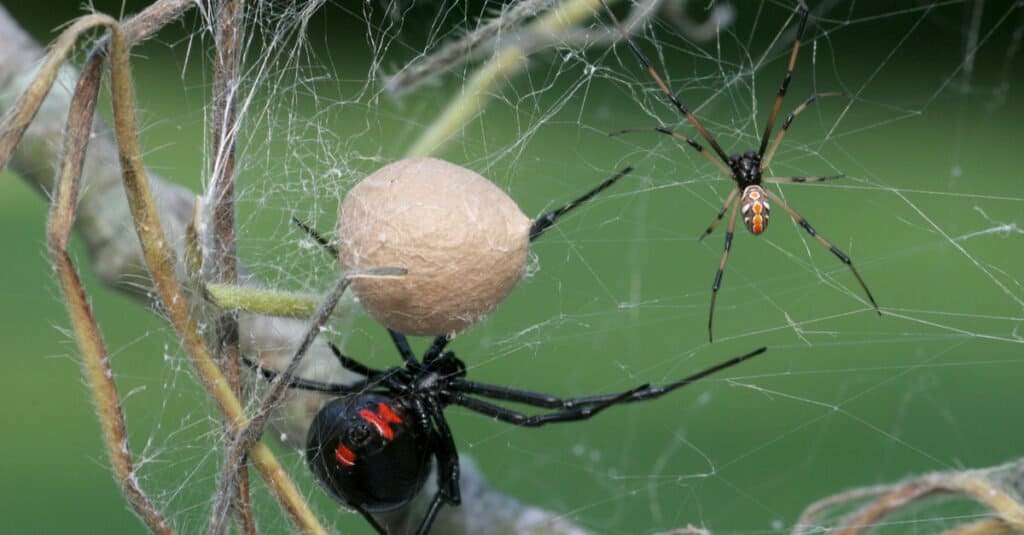
The western black widow possesses potent neurotoxic venom.
©Mark_Kostich/Shutterstock.com
The western black widow, Latrodectus hesperus, is one of the most venomous spiders in Oregon. It belongs to the cobweb spider family Theridiidae and ranges throughout most of the western half of North America.
Female western black widows usually measure from 14 to 16 millimeters long while males measure only about half that size. Like other black widows, they typically appear primarily black aside from an hourglass-shaped marking on the abdomen. While usually red, this marking can also appear yellow or white.
Unlike some other widow spiders, western black widows very rarely engage in cannibalism after mating. They hunt by waiting for insects to get entangled in the sticky threads of their irregularly-shaped cobwebs. Their venom contains a powerful neurotoxin that can cause a number of medical complications. Common symptoms include pain, fever, and nausea.
#6. Zebra Spider
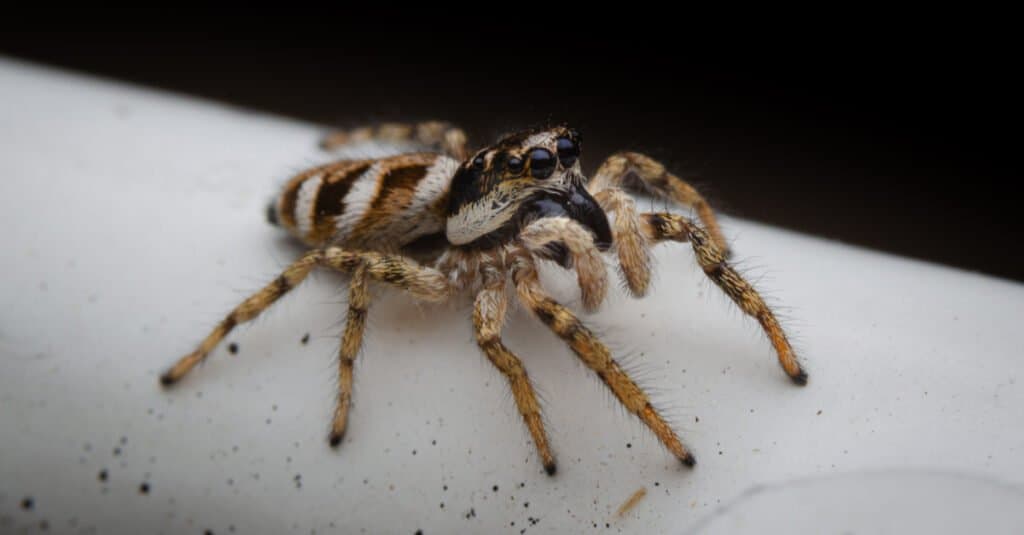
The zebra black spider has excellent binocular vision.
©Mario.Pieper/Shutterstock.com
Salticus scenicus, or the zebra spider, is one of the most visually striking spiders in Oregon. A member of the jumping spider family Salticidae, it ranges throughout much of the northern hemisphere.
Adult females measure between 8 and 15 millimeters long while males measure from 6 to 13 millimeters long. Like other jumping spiders, they possess large eyes and mouthparts. They feature black and white stripes on the carapace, abdomen, and legs that resemble the stripes on a zebra, hence their name.
The zebra spider’s scientific name translates to “theatrical dancing” in English, which refers both to its appearance and agility. Instead of using webs to catch its prey it relies on its keen eyesight and leaping ability. You can often find it wandering around on plants, fences, walls, or window sills in search of prey. Due to their size, their bite usually can’t pierce human skin.
#5. Black-Footed Yellow Sac Spider
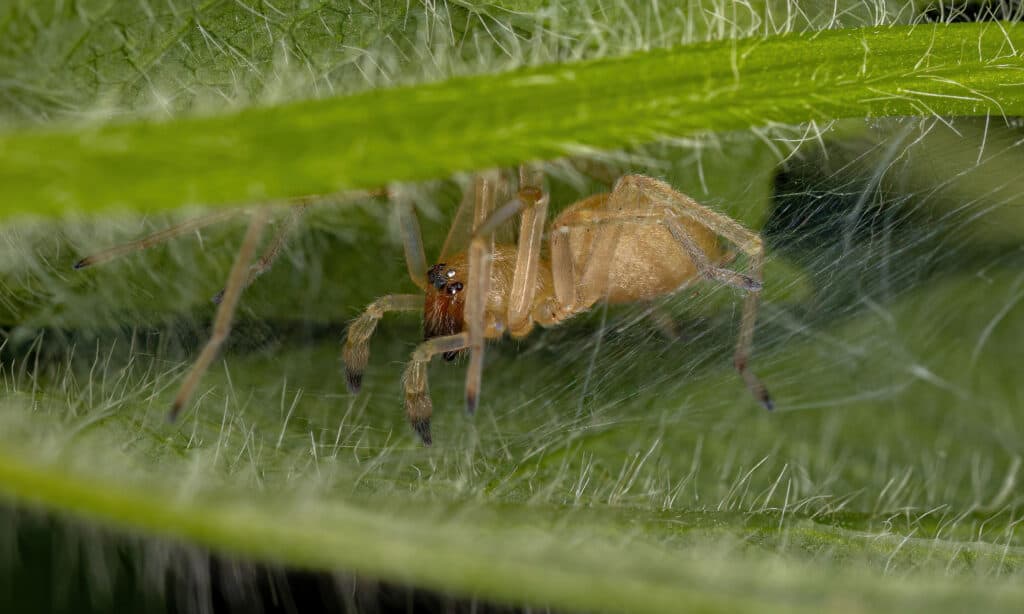
The black-footed yellow sac spider builds a silk sac to protect itself from predators during the day.
©iStock.com/ViniSouza128
The black-footed yellow sac spider, Cheiracanthium inclusum, also goes by the American yellow sac spider. It belongs to the family Cheiracanthiidae and ranges throughout much of North and South America.
Females black-footed yellow sac spiders measure from 5 to 9 millimeters long. Meanwhile, males typically measure 4 to 8 millimeters in length. They appear primarily pale yellow and sport dark brown markings at the ends of their jaws and feet, hence their name. That said, the abdomen often features an orange-brown stripe down the middle, but not always.
Blacked-footed yellow sac spiders are active hunters that do not use webs to capture prey. They tend to hunt at night and then retreat to silken shelters during the day to protect themselves from predators. You can often find these spiders in Oregon climbing on a single silk strand, which they sometimes ride like a balloon in the wind.
#4. Giant Crab Spider
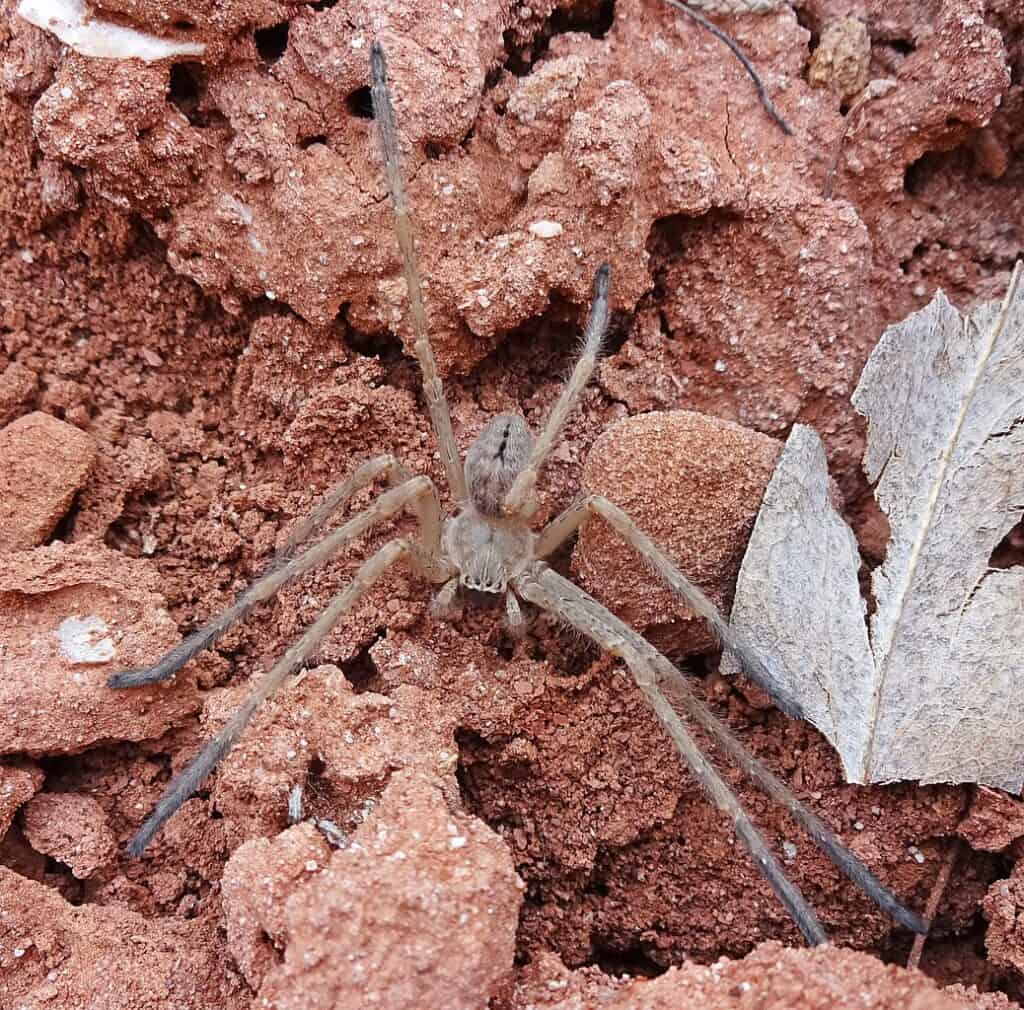
Giant crab spiders can measure 6 inches long with their legs extended.
©Andrey Zharkikh from Salt Lake City, USA / CC BY 2.0, via Wikimedia Commons – License
Olios giganteus, or the giant crab spider, belongs to the giant crab or huntsman spider family Sparassidae. It easily ranks as one of the largest spiders in Oregon. You can also find it throughout much of the western United States and parts of Mexico.
Adult giant crab spiders can measure up to 6 inches long with their legs extended. That said, their bodies typically measure around 20 millimeters long. They appear predominantly light brown, black, tan, and orange. However, the abdomen features black Y-shaped markings.
Giant crab spiders do not use webs to capture their prey. Instead, they actively hunt insects and other spiders using their speed and power. They are known to act quite aggressively, particularly when protecting their eggs from predators. In addition to pain, their bite may cause nausea, swelling, or headaches.
#3. Missing Sector Orb Weaver

The missing sector orb weaver builds a distinctive web with a section missing in the top half.
©iStock.com/Sanjiv Shukla
The missing sector orb weaver, Zygiella x-notata, belongs to the orb weaver family Araneidae. It also goes by the name the silver-sided sector spider. Although primarily found in Europe, you can find it throughout much of the world.
Female missing sector orb weavers measure between 5 and 11 millimeters long and males typically measure about 7 millimeters long. The abdomen appears predominantly silver while the cephalothorax looks yellowish-brown. Additionally, they feature dark markings on the abdomen.
Missing sector orb weavers build one of the most unique webs out of all the orb weaver spiders in Oregon. Their webs typically feature a missing sector in the top half, hence their name. They use their webs to catch prey and rebuild them daily to keep them in good condition. They are notoriously solitary, and although they often live near human dwellings, they rarely bite people.
#2. Giant House Spider
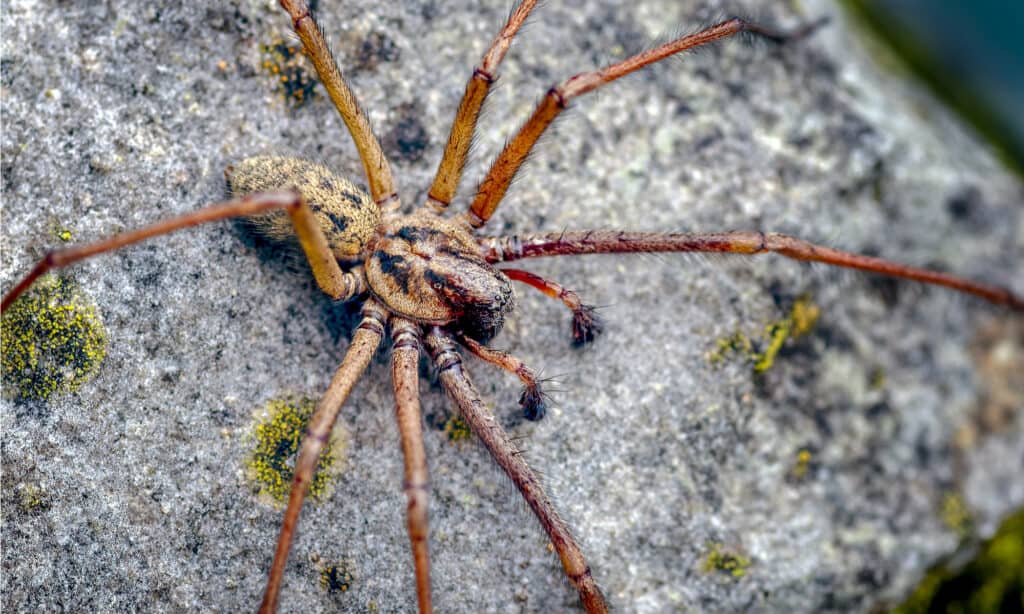
Giant house spiders resemble common house spiders and appear mainly dark brown.
©R K Hill/Shutterstock.com
The giant house spider is a term used to refer to three separate species; Eratigena atrica, E. duellica, and E. saeva. All three spiders belong to the family Agelenidae. While primarily found in Europe, you can also find these spiders in Oregon and other parts of the United States.
Adult females can reach up to 18.5 millimeters long while males typically measure 12 to 15 millimeters long. They somewhat resemble common house spiders and appear primarily dark brown in color. That said, they feature 3 light spots on each side that form an arrow-shaped pattern pointing forward. They possess a large abdomen, legs, and palps, hence their name.
Giant house spiders construct messy, flat funnel webs made of non-sticky silk threads. They hide inside the funnel waiting for insects to wander inside then rush in for the kill. Despite their size, they rarely bite humans and aren’t considered dangerous.
#1. Long-Palped Ant Mimic Sac Spider
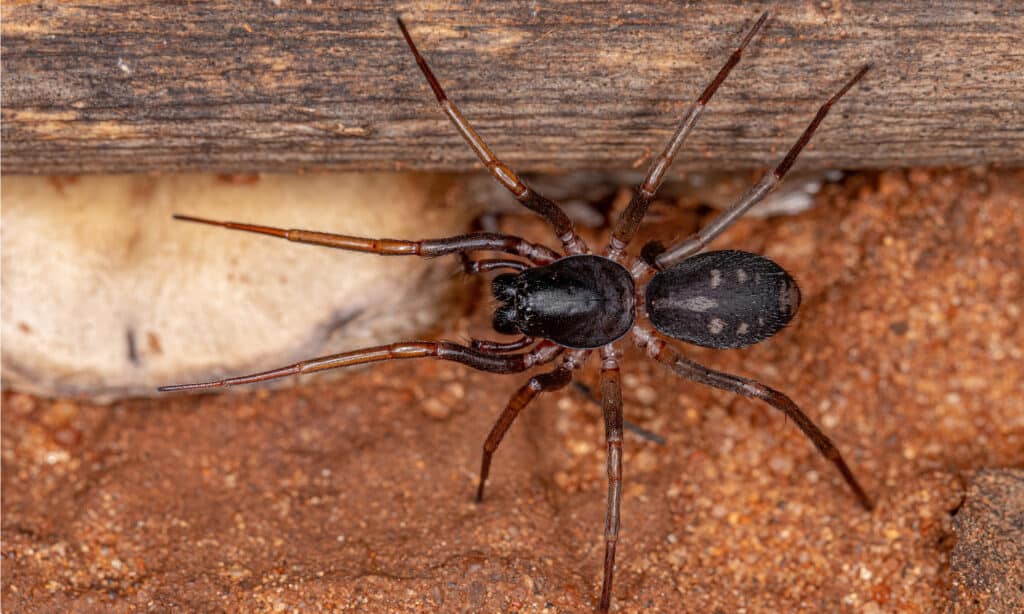
The long-palped ant mimic sac spider use their front two legs like antennae, mimicking the behavior of ants.
©Vinicius R. Souza/Shutterstock.com
The long-palped ant mimic sac spider, Castianeira longipalpa, belongs to the corinnid sac spider family Corinnidae. You can find these spiders in Oregon as well as throughout the United States and parts of Canada.
Female long-palped ant mimic sac spiders generally measure 13 millimeters in length, while males range from 3 to 6 millimeters long. The abdomen appears primarily black. That said, the abdomen often sports at least 4 lateral white or light grey stripes. Meanwhile, the cephalothorax can look black, grey, brown, or almost white.
Long-palped ant mimic sac spiders do not look like ants, but they do act like them. They use their front two legs like antennae, thereby mimicking the behavior of ants. Supposedly, since they don’t build webs, this behavior allows them to blend in with and ambush ants more effectively. Their bite is not medically significant and poses no threat to humans.
Summary of 10 Spiders in Oregon
Here’s a recap of 10 spiders found in Oregon that we took a look at.
| Number | Spider | Scientific Name | Length |
|---|---|---|---|
| 1 | Long-Palped Ant Mimic Sac Spider | Castianeira longipalpa | Females: 13 mm; males: 3-6 mm |
| 2 | Giant House Spider | Eratigena atrica, E. duellica, E. saeva | Females: up to 18.5 mm; males: 12-15 mm |
| 3 | Missing Sector Orb Weaver | Zygiella x-notata | Females: 5-11 mm; males: 7 mm |
| 4 | Giant Crab Spider | Olios giganteus | Up to 6 inches long with legs extended; bodies typically are around 20 mm long |
| 5 | Black-Footed Yellow Sac Spider | Cheiracanthium inclusum | Female: 5-9 mm; males: 4-8 mm |
| 6 | Zebra Spider | Salticus scenicus | Females: 8-15 mm; males: 6-13 mm |
| 7 | Western Black Widow | Latrodectus hesperus | Females: 14-16 mm; males measure only about half that size |
| 8 | Mouse Spider | Scotophaeus blackwalli | Females: up to 12 mm; males usually measure no more than 9 mm |
| 9 | Hobo Spider | Eratigena agrestis | 7-14 mm; males are smaller than females |
| 10 | Grey House Spider | Badumna longinqua | Females: up to 14 mm; males average 10 mm |
The photo featured at the top of this post is © Mark_Kostich/Shutterstock.com
Thank you for reading! Have some feedback for us? Contact the AZ Animals editorial team.






